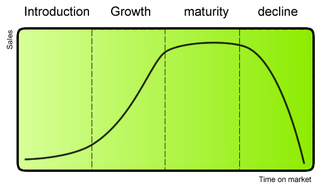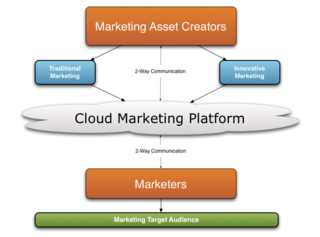Related Research Articles

Marketing is the act of satisfying and retaining customers. It is one of the primary components of business management and commerce.
Positioning refers to the place that a brand occupies in the minds of the customers and how it is distinguished from the products of the competitors. It is different from the concept of brand awareness. In order to position products or brands, companies may emphasize the distinguishing features of their brand or they may try to create a suitable image through the marketing mix. Once a brand has achieved a strong position, it can become difficult to reposition it. To effectively position a brand and create a lasting brand memory, brands need to be able to connect to consumers in an authentic way, creating a brand persona usually helps build this sort of connection.
A marketing plan is a strategy or outline created to accomplish a marketing team's objectives. A marketing plan is often created together by marketing managers, product marketing managers, product managers, and sales teams. A marketing plan falls under the umbrella of the overall business plan.
In marketing, market segmentation is the process of dividing a broad consumer or business market, normally consisting of existing and potential customers, into sub-groups of consumers based on shared characteristics.

Product life-cycle management (PLM) is the succession of strategies by business management as a product goes through its life-cycle. The conditions in which a product is sold changes over time and must be managed as it moves through its succession of stages.
Marketing management is the strategic organizational discipline which focuses on the practical application of marketing orientation, techniques and methods inside enterprises and organizations and on the management of a firm's marketing resources and activities.
Marketing warfare strategies represent a type of strategy, used in commerce and marketing, that tries to draw parallels between business and warfare and then applies the principles of military strategy to business situations, with competing firms considered as analogous to sides in a military conflict, and market share considered as analogous to territory in dispute. This view of marketing argues that in mature, low-growth markets, where real GDP growth is negative or low, commerce operates as a zero-sum game. One participant's gain is possible only at another participant's expense. Success depends on battling competitors for market share.
Marketing strategy is an organization's promotional efforts to allocate its resources across a wide range of platforms and channels to increase its sales and achieve sustainable competitive advantage within its corresponding market.
Market penetration refers to the successful selling of a good or service in a specific market. It involves using tactics that increase the growth of an existing product in an existing market. It is measured by the amount of sales volume of an existing good or service compared to the total target market for that product or service. Market penetration is the key for a business growth strategy stemming from the Ansoff Matrix (Richardson, M., & Evans, C.. H. Igor Ansoff first devised and published the Ansoff Matrix in the Harvard Business Review in 1957, within an article titled "Strategies for Diversification". The grid/matrix is utilized across businesses to help evaluate and determine the next stages the company must take in order to grow and the risks associated with the chosen strategy. With numerous options available, this matrix helps narrow down the best fit for an organization.
Commercialization or commercialisation is the process of introducing a new product or production method into commerce—making it available on the market. The term often connotes especially entry into the mass market, but it also includes a move from the laboratory into commerce. Many technologies begin in a research and development laboratory or in an inventor's workshop and may not be practical for commercial use in their infancy. The "development" segment of the "research and development" spectrum requires time and money as systems are engineered with a view to making the product or method a paying commercial proposition.
In marketing, geomarketing is a discipline that uses geolocation in the process of planning and implementation of marketing activities. It can be used in any aspect of the marketing mix — the product, price, promotion, or place. Market segments can also correlate with location, and this can be useful in targeted marketing.
The target audience is the intended audience or readership of a publication, advertisement, or other message catered specifically to the previously intended audience. In marketing and advertising, the target audience is a particular group of consumer within the predetermined target market, identified as the targets or recipients for a particular advertisement or message.
Diversification is a corporate strategy to enter into or start new products or product lines, new services or new markets, involving substantially different skills, technology and knowledge.
The following outline is provided as an overview of and topical guide to marketing:

Digital marketing is the component of marketing that uses the Internet and online-based digital technologies such as desktop computers, mobile phones, and other digital media and platforms to promote products and services. Its development during the 1990s and 2000s changed the way brands and businesses use technology for marketing. As digital platforms became increasingly incorporated into marketing plans and everyday life, and as people increasingly used digital devices instead of visiting physical shops, digital marketing campaigns have become prevalent, employing combinations of search engine optimization (SEO), search engine marketing (SEM), content marketing, influencer marketing, content automation, campaign marketing, data-driven marketing, e-commerce marketing, social media marketing, social media optimization, e-mail direct marketing, display advertising, e-books, and optical disks and games have become commonplace. Digital marketing extends to non-Internet channels that provide digital media, such as television, mobile phones, callbacks, and on-hold mobile ringtones. The extension to non-Internet channels differentiates digital marketing from online marketing.
A target market, also known as serviceable obtainable market (SOM), is a group of customers within a business's serviceable available market at which a business aims its marketing efforts and resources. A target market is a subset of the total market for a product or service.

The Ansoff matrix is a strategic planning tool that provides a framework to help executives, senior managers, and marketers devise strategies for future business growth. It is named after Russian American Igor Ansoff, an applied mathematician and business manager, who created the concept.
In marketing strategy, cannibalization is a reduction in sales volume, sales revenue, or market share of one product when the same company introduces a new product.
Product marketing is a sub-field of marketing that is responsible for crafting the messaging, go-to-market flow, and promotion of a product. Product marketing managers can also be involved in defining and sizing target markets. They collaborate with other stakeholders including business development, sales, and technical functions such as product management and engineering. Other critical responsibilities include positioning and sales enablement.

Cloud marketing is the process of an organization's efforts to market their goods and services online through integrated digital experiences, by which they are specialised for every end-user. It aims to use advertising methods to give tailor made adverts to customers based on their browsing history or intersets via online applications through social media websites such as Facebook, Twitter and various online portals. Cloud marketing platforms could be supported by third party providers that maintain the platform.
References
- ↑ Jones, Rob (2019). Business Student Book 2. Pearson Education Limited.